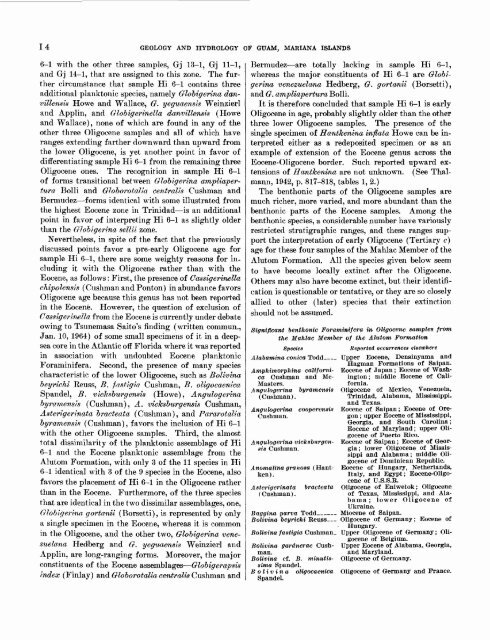Smaller Foraminifera From Guam - USGS
Smaller Foraminifera From Guam - USGS
Smaller Foraminifera From Guam - USGS
Create successful ePaper yourself
Turn your PDF publications into a flip-book with our unique Google optimized e-Paper software.
14 GEOLOGY AND HYDROLOGY OF GUAM, MARIANA ISLANDS<br />
6-1 with the other three samples, Gj 13-1, Gj 11-1,<br />
and Gj 14-1, that are assigned to this zone. The fur<br />
ther circumstance that sample Hi 6-1 contains three<br />
additional planktonic species, namely Globigerina dan-<br />
vUlensis Howe and Wallace, G. yeguaensis Weinzierl<br />
and Applin, and Globigerinella danvittensi-s (Howe<br />
and Wallace), none of which are found in any of the<br />
other three Oligocene samples and all of which have<br />
ranges extending farther downward than upward from<br />
the lower Oligocene, is yet another point in favor of<br />
differentiating sample Hi 6-1 from the remaining three<br />
Oligocene ones. The recognition in sample Hi 6-1<br />
of forms transitional between Globigerina ampliaper-<br />
tura Bolli and Globorotalia centralis Cushman and<br />
Bermudez forms identical with some illustrated from<br />
the highest Eocene zone in Trinidad is an additional<br />
point in favor of interpreting Hi 6-1 as slightly older<br />
than the Globigerina sellii zone.<br />
Nevertheless, in spite of the fact that the previously<br />
discussed points favor a pre-early Oligocene age for<br />
sample Hi 6-1, there are some weighty reasons for in<br />
cluding it with the Oligocene rather than with the<br />
Eocene, as follows: First, the presence of Cassigerinella<br />
chipolensis (Cushman and Ponton) in abundance favors<br />
Oligocene age because this genus has not been reported<br />
in the Eocene. However, the question of exclusion of<br />
Cassigerinella from the Eocene is currently under debate<br />
owing to Tsunemasa Saito's finding (written commun.,<br />
Jan. 10, 1964) of some small specimens of it in a deep-<br />
sea core in the Atlantic off Florida where it was reported<br />
in association with undoubted Eocene planktonic<br />
<strong>Foraminifera</strong>. Second, the presence of many species<br />
characteristic of the lower Oligocene, such as Bolivina<br />
l>eyrichi Reuss, B. fastigia Cushman, B. olig

















